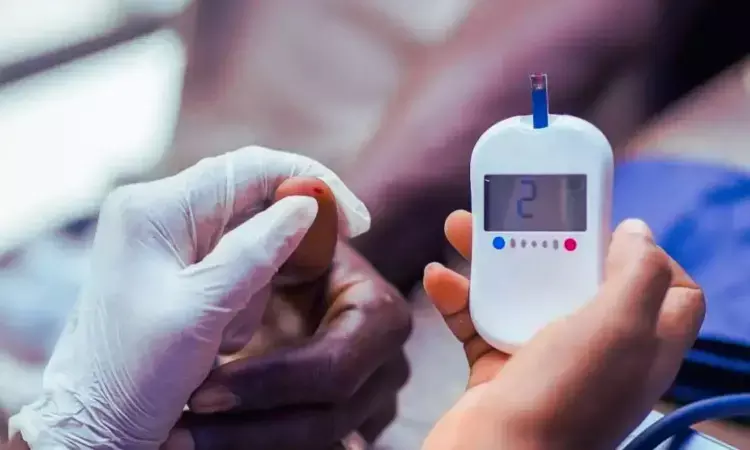- Home
- Medical news & Guidelines
- Anesthesiology
- Cardiology and CTVS
- Critical Care
- Dentistry
- Dermatology
- Diabetes and Endocrinology
- ENT
- Gastroenterology
- Medicine
- Nephrology
- Neurology
- Obstretics-Gynaecology
- Oncology
- Ophthalmology
- Orthopaedics
- Pediatrics-Neonatology
- Psychiatry
- Pulmonology
- Radiology
- Surgery
- Urology
- Laboratory Medicine
- Diet
- Nursing
- Paramedical
- Physiotherapy
- Health news
- Fact Check
- Bone Health Fact Check
- Brain Health Fact Check
- Cancer Related Fact Check
- Child Care Fact Check
- Dental and oral health fact check
- Diabetes and metabolic health fact check
- Diet and Nutrition Fact Check
- Eye and ENT Care Fact Check
- Fitness fact check
- Gut health fact check
- Heart health fact check
- Kidney health fact check
- Medical education fact check
- Men's health fact check
- Respiratory fact check
- Skin and hair care fact check
- Vaccine and Immunization fact check
- Women's health fact check
- AYUSH
- State News
- Andaman and Nicobar Islands
- Andhra Pradesh
- Arunachal Pradesh
- Assam
- Bihar
- Chandigarh
- Chattisgarh
- Dadra and Nagar Haveli
- Daman and Diu
- Delhi
- Goa
- Gujarat
- Haryana
- Himachal Pradesh
- Jammu & Kashmir
- Jharkhand
- Karnataka
- Kerala
- Ladakh
- Lakshadweep
- Madhya Pradesh
- Maharashtra
- Manipur
- Meghalaya
- Mizoram
- Nagaland
- Odisha
- Puducherry
- Punjab
- Rajasthan
- Sikkim
- Tamil Nadu
- Telangana
- Tripura
- Uttar Pradesh
- Uttrakhand
- West Bengal
- Medical Education
- Industry
One-Hour Plasma Glucose Better at Predicting Prediabetes Than Standard Tests: Study

USA: Researchers have found in a new study that one-hour plasma glucose (1-h PG) levels may be a more accurate predictor of future prediabetes than fasting plasma glucose (FPG) and two-hour PG, highlighting a potential gap in current ADA diagnostic criteria. The study has been published in Diabetes Care.
Led by Dr. Muhammad Abdul-Ghani from the Diabetes Division at the University of Texas Health Science Center, San Antonio, the research analysed data from the long-running San Antonio Heart Study to explore how well 1-h PG concentrations during an oral glucose tolerance test (OGTT) can predict the onset of prediabetes among individuals with initially normal glucose tolerance (NGT).
The analysis included 1,557 adults who were free of type 2 diabetes at the beginning of the study. Each participant underwent an OGTT at baseline and a follow-up OGTT after an average of 7.5 years. Using American Diabetes Association criteria, the researchers evaluated how well the 1-h PG values could forecast the likelihood of progression to prediabetes.
The key findings of the study were as follows:
- At a 7.5-year follow-up, nearly 25% of individuals with normal glucose tolerance (NGT) at baseline progressed to prediabetes.
- 22.5% of participants with 1-hour plasma glucose (1-h PG) levels below 155 mg/dL progressed to prediabetes, compared to 42.5% of those with 1-h PG levels above 155 mg/dL.
- The 1-h PG level was the strongest predictor of future prediabetes risk among all glucose measures.
- A 1-h PG threshold of 120 mg/dL showed 61% sensitivity and 67% specificity in identifying individuals at high risk of developing prediabetes.
- Participants with 1-h PG levels between 120–155 mg/dL who developed prediabetes exhibited significant insulin resistance and metabolic abnormalities typical of insulin resistance syndrome.
- The authors suggested using the term "pre-prediabetes" to describe individuals with 1-h PG in the 120–155 mg/dL range, due to their higher risk of glucose deterioration.
- Elevated 1-h PG levels may serve as an early marker of metabolic dysregulation, appearing well before the onset of clinically defined prediabetes.
- Early identification of individuals with elevated 1-h PG levels could enable targeted interventions to prevent disease progression.
The authors concluded that a rise in 1-hour plasma glucose (1-h PG) levels occurs before the onset of prediabetes and can help identify individuals with 1-h PG between 120–155 mg/dL who are at a higher risk of developing prediabetes. They suggest referring to this group as "pre-prediabetes" to emphasize their elevated risk of worsening blood sugar levels.
The authors recommend incorporating 1-h PG measurements into clinical practice to improve risk assessment and guide targeted preventive strategies.
Reference:
Muhammad Abdul-Ghani, Mohamed Abu-Farha, Tamam Abdul-Ghani, Alberto Chavez-Velazquez, Auora Merovci, Ralph A. DeFronzo, Fahad Alajmi, Michael Stern, Fahd Al-Mulla; One-Hour Plasma Glucose Predicts the Progression From Normal Glucose Tolerance to Prediabetes. Diabetes Care 2025; dc242832. https://doi.org/10.2337/dc24-2832
Dr Kamal Kant Kohli-MBBS, DTCD- a chest specialist with more than 30 years of practice and a flair for writing clinical articles, Dr Kamal Kant Kohli joined Medical Dialogues as a Chief Editor of Medical News. Besides writing articles, as an editor, he proofreads and verifies all the medical content published on Medical Dialogues including those coming from journals, studies,medical conferences,guidelines etc. Email: drkohli@medicaldialogues.in. Contact no. 011-43720751


